Business Environment Analysis Report: Types, Size, and Structure
VerifiedAdded on 2020/10/05
|17
|6363
|104
Report
AI Summary
This report provides a comprehensive analysis of the business environment, examining various organizational types such as public, private, and voluntary sectors, sole traders, and partnerships. It delves into the interrelationship between organizational functions and structures, including functional and hierarchical structures, and how they impact business operations. The report also includes a PESTEL analysis of Marks & Spencer, evaluating the macro-environmental factors influencing the company. Furthermore, it assesses the strengths and weaknesses of businesses and the influence of both macro and micro factors on their performance. The report uses examples of companies like River Island, John Lewis, and Kurt Geiger to illustrate key concepts, making it a valuable resource for understanding the complexities of the business world. The report concludes by summarizing key findings and offering insights into the dynamic nature of the business environment.
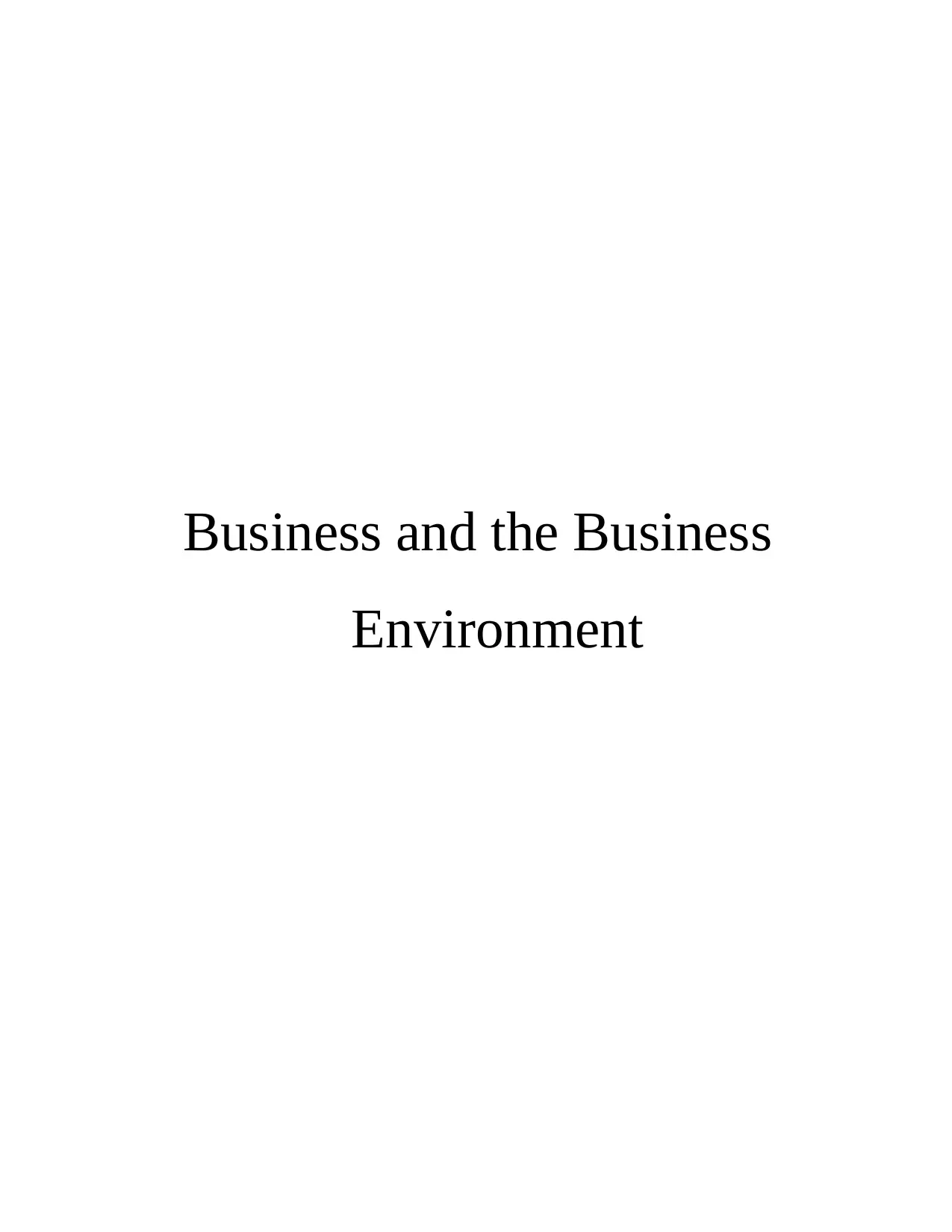
Business and the Business
Environment
Environment
Paraphrase This Document
Need a fresh take? Get an instant paraphrase of this document with our AI Paraphraser

Table of Contents
INTRODUCTION...........................................................................................................................3
TASK 1............................................................................................................................................3
LO 1. Different types, size and scope of organisations...............................................................3
TASK 2 ...........................................................................................................................................5
LO 2 Interrelationship of functions with different organisational structure and connection......6
TASK 3............................................................................................................................................8
LO 3 PESTEL analysis of Marks & Spencer company. ............................................................8
TASK 4..........................................................................................................................................10
LO 4 Strength and Weaknesses and influence of macro and micro factors on business..........10
CONCLUSION..............................................................................................................................14
REFERENCES..............................................................................................................................15
INTRODUCTION...........................................................................................................................3
TASK 1............................................................................................................................................3
LO 1. Different types, size and scope of organisations...............................................................3
TASK 2 ...........................................................................................................................................5
LO 2 Interrelationship of functions with different organisational structure and connection......6
TASK 3............................................................................................................................................8
LO 3 PESTEL analysis of Marks & Spencer company. ............................................................8
TASK 4..........................................................................................................................................10
LO 4 Strength and Weaknesses and influence of macro and micro factors on business..........10
CONCLUSION..............................................................................................................................14
REFERENCES..............................................................................................................................15
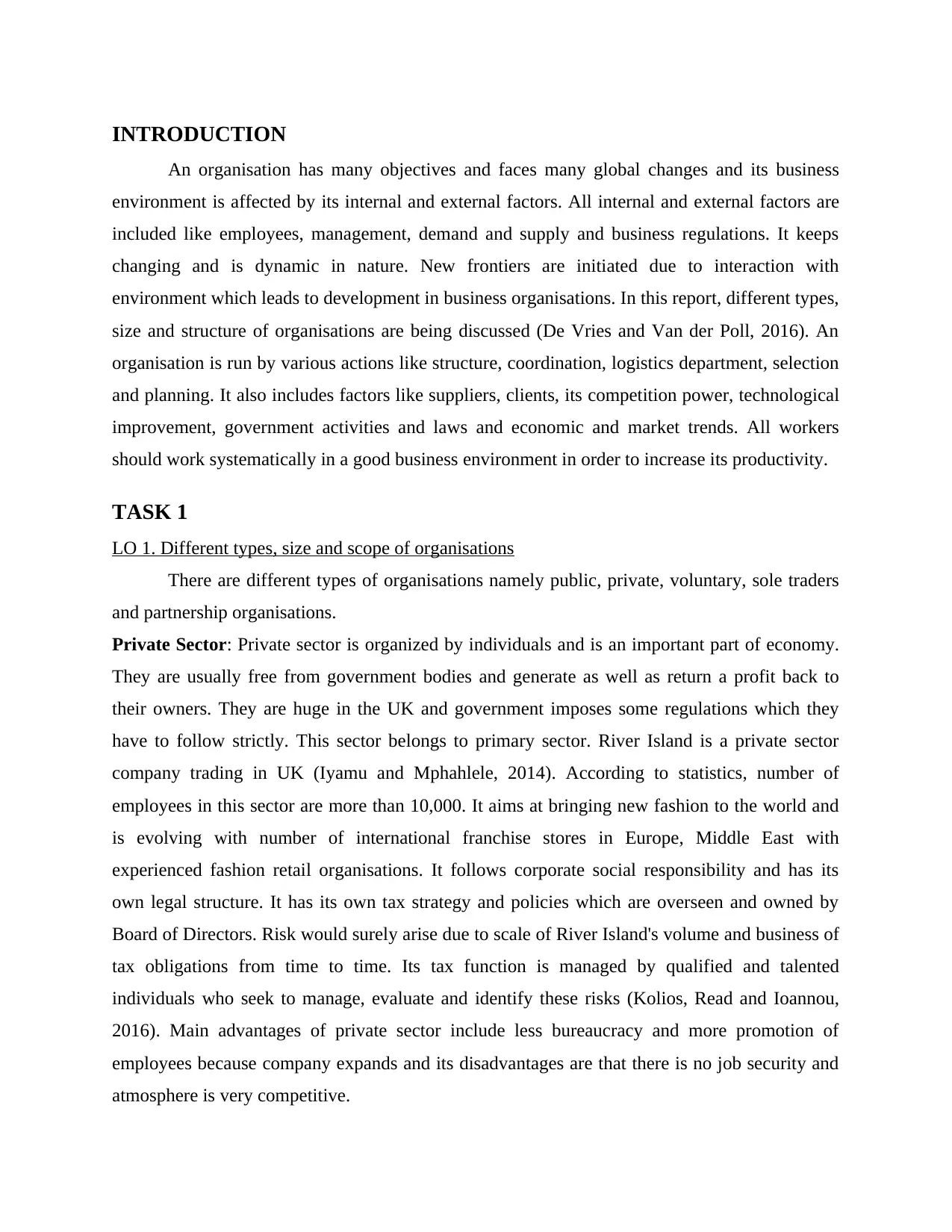
INTRODUCTION
An organisation has many objectives and faces many global changes and its business
environment is affected by its internal and external factors. All internal and external factors are
included like employees, management, demand and supply and business regulations. It keeps
changing and is dynamic in nature. New frontiers are initiated due to interaction with
environment which leads to development in business organisations. In this report, different types,
size and structure of organisations are being discussed (De Vries and Van der Poll, 2016). An
organisation is run by various actions like structure, coordination, logistics department, selection
and planning. It also includes factors like suppliers, clients, its competition power, technological
improvement, government activities and laws and economic and market trends. All workers
should work systematically in a good business environment in order to increase its productivity.
TASK 1
LO 1. Different types, size and scope of organisations
There are different types of organisations namely public, private, voluntary, sole traders
and partnership organisations.
Private Sector: Private sector is organized by individuals and is an important part of economy.
They are usually free from government bodies and generate as well as return a profit back to
their owners. They are huge in the UK and government imposes some regulations which they
have to follow strictly. This sector belongs to primary sector. River Island is a private sector
company trading in UK (Iyamu and Mphahlele, 2014). According to statistics, number of
employees in this sector are more than 10,000. It aims at bringing new fashion to the world and
is evolving with number of international franchise stores in Europe, Middle East with
experienced fashion retail organisations. It follows corporate social responsibility and has its
own legal structure. It has its own tax strategy and policies which are overseen and owned by
Board of Directors. Risk would surely arise due to scale of River Island's volume and business of
tax obligations from time to time. Its tax function is managed by qualified and talented
individuals who seek to manage, evaluate and identify these risks (Kolios, Read and Ioannou,
2016). Main advantages of private sector include less bureaucracy and more promotion of
employees because company expands and its disadvantages are that there is no job security and
atmosphere is very competitive.
An organisation has many objectives and faces many global changes and its business
environment is affected by its internal and external factors. All internal and external factors are
included like employees, management, demand and supply and business regulations. It keeps
changing and is dynamic in nature. New frontiers are initiated due to interaction with
environment which leads to development in business organisations. In this report, different types,
size and structure of organisations are being discussed (De Vries and Van der Poll, 2016). An
organisation is run by various actions like structure, coordination, logistics department, selection
and planning. It also includes factors like suppliers, clients, its competition power, technological
improvement, government activities and laws and economic and market trends. All workers
should work systematically in a good business environment in order to increase its productivity.
TASK 1
LO 1. Different types, size and scope of organisations
There are different types of organisations namely public, private, voluntary, sole traders
and partnership organisations.
Private Sector: Private sector is organized by individuals and is an important part of economy.
They are usually free from government bodies and generate as well as return a profit back to
their owners. They are huge in the UK and government imposes some regulations which they
have to follow strictly. This sector belongs to primary sector. River Island is a private sector
company trading in UK (Iyamu and Mphahlele, 2014). According to statistics, number of
employees in this sector are more than 10,000. It aims at bringing new fashion to the world and
is evolving with number of international franchise stores in Europe, Middle East with
experienced fashion retail organisations. It follows corporate social responsibility and has its
own legal structure. It has its own tax strategy and policies which are overseen and owned by
Board of Directors. Risk would surely arise due to scale of River Island's volume and business of
tax obligations from time to time. Its tax function is managed by qualified and talented
individuals who seek to manage, evaluate and identify these risks (Kolios, Read and Ioannou,
2016). Main advantages of private sector include less bureaucracy and more promotion of
employees because company expands and its disadvantages are that there is no job security and
atmosphere is very competitive.
⊘ This is a preview!⊘
Do you want full access?
Subscribe today to unlock all pages.

Trusted by 1+ million students worldwide
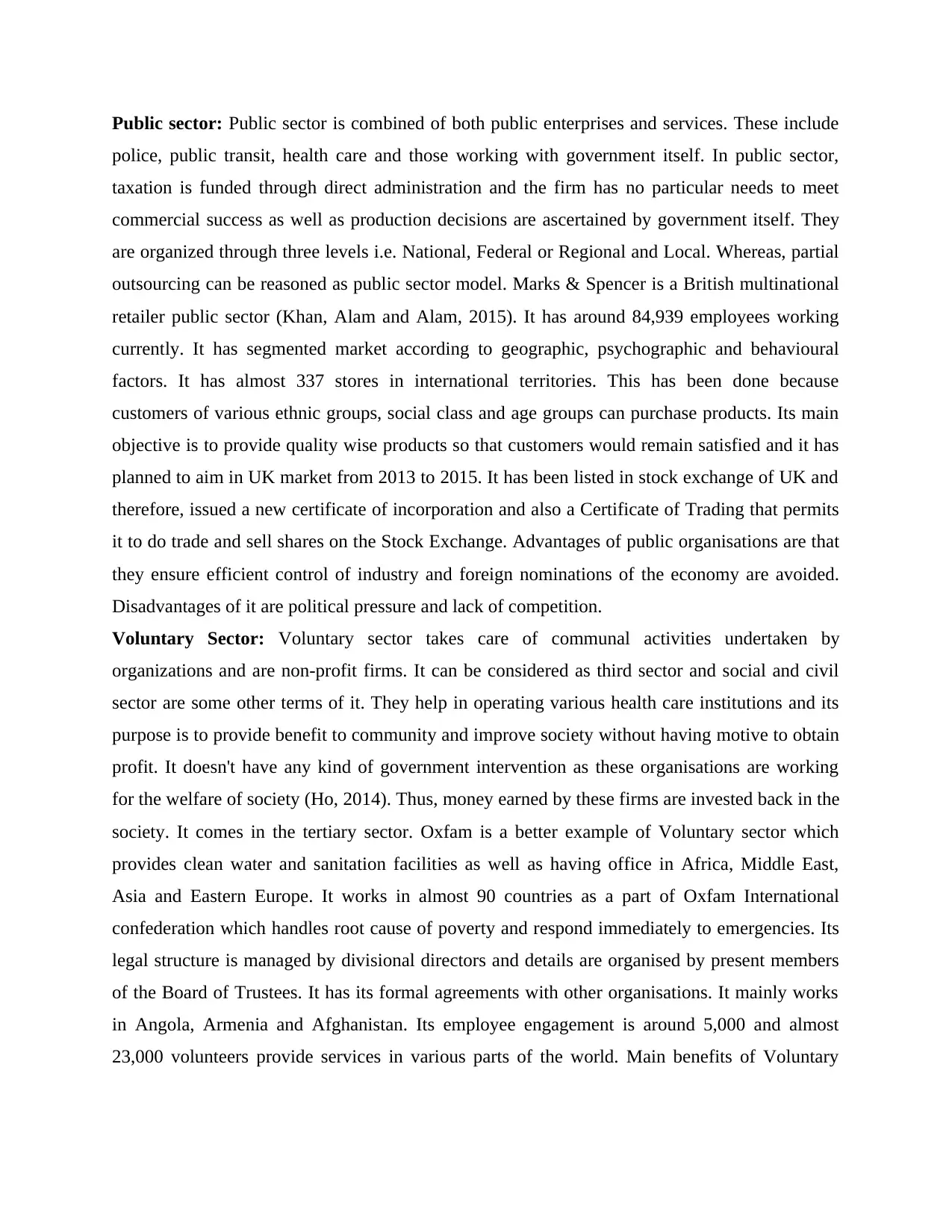
Public sector: Public sector is combined of both public enterprises and services. These include
police, public transit, health care and those working with government itself. In public sector,
taxation is funded through direct administration and the firm has no particular needs to meet
commercial success as well as production decisions are ascertained by government itself. They
are organized through three levels i.e. National, Federal or Regional and Local. Whereas, partial
outsourcing can be reasoned as public sector model. Marks & Spencer is a British multinational
retailer public sector (Khan, Alam and Alam, 2015). It has around 84,939 employees working
currently. It has segmented market according to geographic, psychographic and behavioural
factors. It has almost 337 stores in international territories. This has been done because
customers of various ethnic groups, social class and age groups can purchase products. Its main
objective is to provide quality wise products so that customers would remain satisfied and it has
planned to aim in UK market from 2013 to 2015. It has been listed in stock exchange of UK and
therefore, issued a new certificate of incorporation and also a Certificate of Trading that permits
it to do trade and sell shares on the Stock Exchange. Advantages of public organisations are that
they ensure efficient control of industry and foreign nominations of the economy are avoided.
Disadvantages of it are political pressure and lack of competition.
Voluntary Sector: Voluntary sector takes care of communal activities undertaken by
organizations and are non-profit firms. It can be considered as third sector and social and civil
sector are some other terms of it. They help in operating various health care institutions and its
purpose is to provide benefit to community and improve society without having motive to obtain
profit. It doesn't have any kind of government intervention as these organisations are working
for the welfare of society (Ho, 2014). Thus, money earned by these firms are invested back in the
society. It comes in the tertiary sector. Oxfam is a better example of Voluntary sector which
provides clean water and sanitation facilities as well as having office in Africa, Middle East,
Asia and Eastern Europe. It works in almost 90 countries as a part of Oxfam International
confederation which handles root cause of poverty and respond immediately to emergencies. Its
legal structure is managed by divisional directors and details are organised by present members
of the Board of Trustees. It has its formal agreements with other organisations. It mainly works
in Angola, Armenia and Afghanistan. Its employee engagement is around 5,000 and almost
23,000 volunteers provide services in various parts of the world. Main benefits of Voluntary
police, public transit, health care and those working with government itself. In public sector,
taxation is funded through direct administration and the firm has no particular needs to meet
commercial success as well as production decisions are ascertained by government itself. They
are organized through three levels i.e. National, Federal or Regional and Local. Whereas, partial
outsourcing can be reasoned as public sector model. Marks & Spencer is a British multinational
retailer public sector (Khan, Alam and Alam, 2015). It has around 84,939 employees working
currently. It has segmented market according to geographic, psychographic and behavioural
factors. It has almost 337 stores in international territories. This has been done because
customers of various ethnic groups, social class and age groups can purchase products. Its main
objective is to provide quality wise products so that customers would remain satisfied and it has
planned to aim in UK market from 2013 to 2015. It has been listed in stock exchange of UK and
therefore, issued a new certificate of incorporation and also a Certificate of Trading that permits
it to do trade and sell shares on the Stock Exchange. Advantages of public organisations are that
they ensure efficient control of industry and foreign nominations of the economy are avoided.
Disadvantages of it are political pressure and lack of competition.
Voluntary Sector: Voluntary sector takes care of communal activities undertaken by
organizations and are non-profit firms. It can be considered as third sector and social and civil
sector are some other terms of it. They help in operating various health care institutions and its
purpose is to provide benefit to community and improve society without having motive to obtain
profit. It doesn't have any kind of government intervention as these organisations are working
for the welfare of society (Ho, 2014). Thus, money earned by these firms are invested back in the
society. It comes in the tertiary sector. Oxfam is a better example of Voluntary sector which
provides clean water and sanitation facilities as well as having office in Africa, Middle East,
Asia and Eastern Europe. It works in almost 90 countries as a part of Oxfam International
confederation which handles root cause of poverty and respond immediately to emergencies. Its
legal structure is managed by divisional directors and details are organised by present members
of the Board of Trustees. It has its formal agreements with other organisations. It mainly works
in Angola, Armenia and Afghanistan. Its employee engagement is around 5,000 and almost
23,000 volunteers provide services in various parts of the world. Main benefits of Voluntary
Paraphrase This Document
Need a fresh take? Get an instant paraphrase of this document with our AI Paraphraser
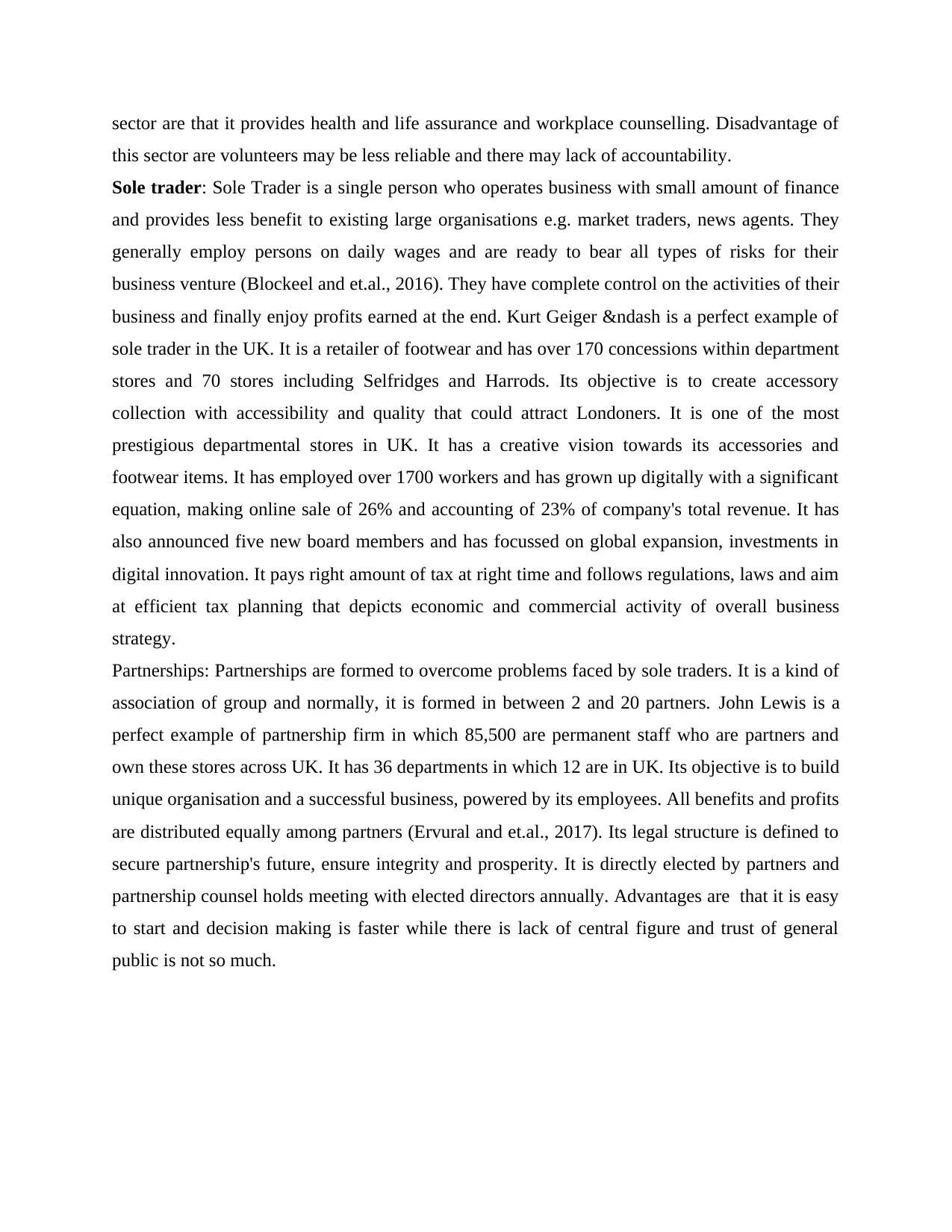
sector are that it provides health and life assurance and workplace counselling. Disadvantage of
this sector are volunteers may be less reliable and there may lack of accountability.
Sole trader: Sole Trader is a single person who operates business with small amount of finance
and provides less benefit to existing large organisations e.g. market traders, news agents. They
generally employ persons on daily wages and are ready to bear all types of risks for their
business venture (Blockeel and et.al., 2016). They have complete control on the activities of their
business and finally enjoy profits earned at the end. Kurt Geiger &ndash is a perfect example of
sole trader in the UK. It is a retailer of footwear and has over 170 concessions within department
stores and 70 stores including Selfridges and Harrods. Its objective is to create accessory
collection with accessibility and quality that could attract Londoners. It is one of the most
prestigious departmental stores in UK. It has a creative vision towards its accessories and
footwear items. It has employed over 1700 workers and has grown up digitally with a significant
equation, making online sale of 26% and accounting of 23% of company's total revenue. It has
also announced five new board members and has focussed on global expansion, investments in
digital innovation. It pays right amount of tax at right time and follows regulations, laws and aim
at efficient tax planning that depicts economic and commercial activity of overall business
strategy.
Partnerships: Partnerships are formed to overcome problems faced by sole traders. It is a kind of
association of group and normally, it is formed in between 2 and 20 partners. John Lewis is a
perfect example of partnership firm in which 85,500 are permanent staff who are partners and
own these stores across UK. It has 36 departments in which 12 are in UK. Its objective is to build
unique organisation and a successful business, powered by its employees. All benefits and profits
are distributed equally among partners (Ervural and et.al., 2017). Its legal structure is defined to
secure partnership's future, ensure integrity and prosperity. It is directly elected by partners and
partnership counsel holds meeting with elected directors annually. Advantages are that it is easy
to start and decision making is faster while there is lack of central figure and trust of general
public is not so much.
this sector are volunteers may be less reliable and there may lack of accountability.
Sole trader: Sole Trader is a single person who operates business with small amount of finance
and provides less benefit to existing large organisations e.g. market traders, news agents. They
generally employ persons on daily wages and are ready to bear all types of risks for their
business venture (Blockeel and et.al., 2016). They have complete control on the activities of their
business and finally enjoy profits earned at the end. Kurt Geiger &ndash is a perfect example of
sole trader in the UK. It is a retailer of footwear and has over 170 concessions within department
stores and 70 stores including Selfridges and Harrods. Its objective is to create accessory
collection with accessibility and quality that could attract Londoners. It is one of the most
prestigious departmental stores in UK. It has a creative vision towards its accessories and
footwear items. It has employed over 1700 workers and has grown up digitally with a significant
equation, making online sale of 26% and accounting of 23% of company's total revenue. It has
also announced five new board members and has focussed on global expansion, investments in
digital innovation. It pays right amount of tax at right time and follows regulations, laws and aim
at efficient tax planning that depicts economic and commercial activity of overall business
strategy.
Partnerships: Partnerships are formed to overcome problems faced by sole traders. It is a kind of
association of group and normally, it is formed in between 2 and 20 partners. John Lewis is a
perfect example of partnership firm in which 85,500 are permanent staff who are partners and
own these stores across UK. It has 36 departments in which 12 are in UK. Its objective is to build
unique organisation and a successful business, powered by its employees. All benefits and profits
are distributed equally among partners (Ervural and et.al., 2017). Its legal structure is defined to
secure partnership's future, ensure integrity and prosperity. It is directly elected by partners and
partnership counsel holds meeting with elected directors annually. Advantages are that it is easy
to start and decision making is faster while there is lack of central figure and trust of general
public is not so much.
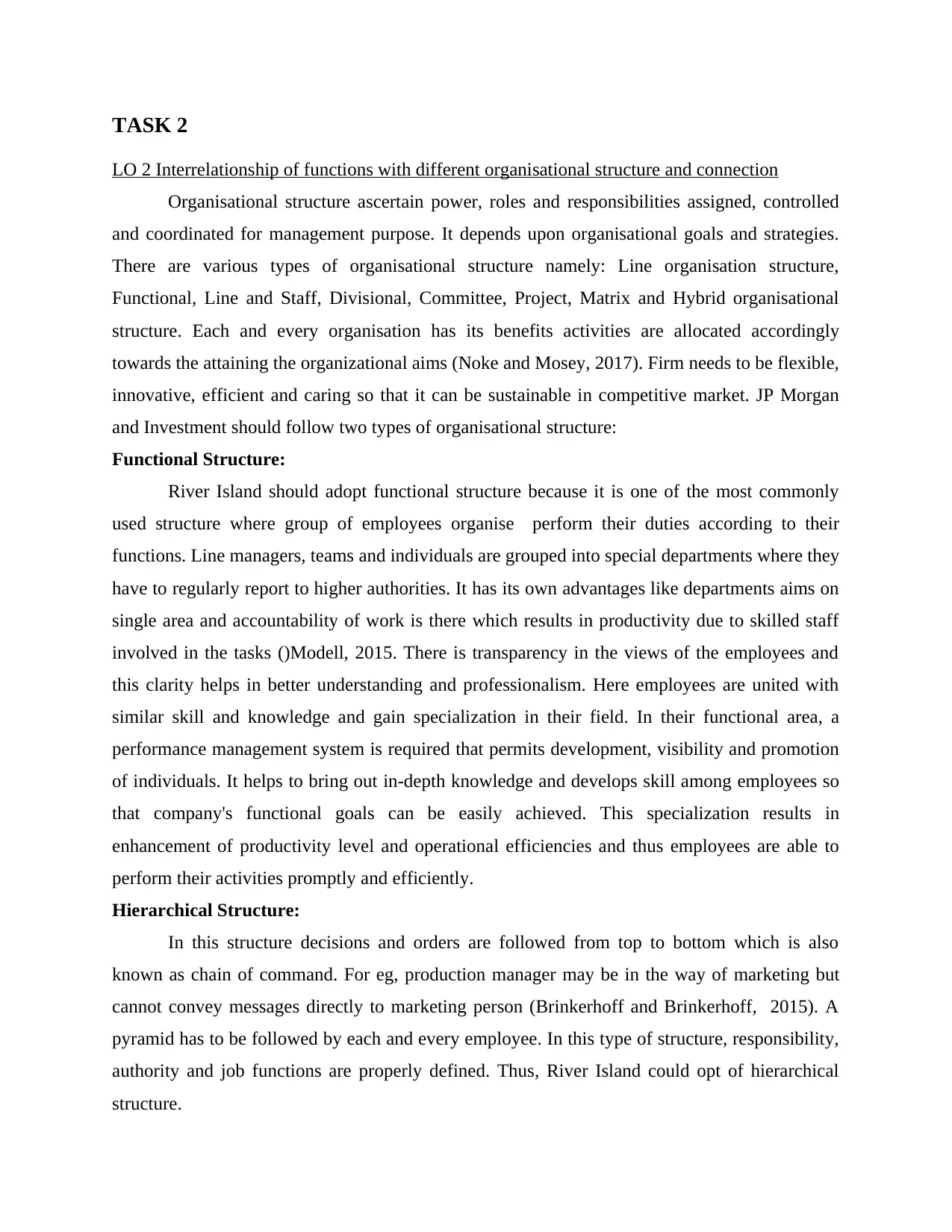
TASK 2
LO 2 Interrelationship of functions with different organisational structure and connection
Organisational structure ascertain power, roles and responsibilities assigned, controlled
and coordinated for management purpose. It depends upon organisational goals and strategies.
There are various types of organisational structure namely: Line organisation structure,
Functional, Line and Staff, Divisional, Committee, Project, Matrix and Hybrid organisational
structure. Each and every organisation has its benefits activities are allocated accordingly
towards the attaining the organizational aims (Noke and Mosey, 2017). Firm needs to be flexible,
innovative, efficient and caring so that it can be sustainable in competitive market. JP Morgan
and Investment should follow two types of organisational structure:
Functional Structure:
River Island should adopt functional structure because it is one of the most commonly
used structure where group of employees organise perform their duties according to their
functions. Line managers, teams and individuals are grouped into special departments where they
have to regularly report to higher authorities. It has its own advantages like departments aims on
single area and accountability of work is there which results in productivity due to skilled staff
involved in the tasks ()Modell, 2015. There is transparency in the views of the employees and
this clarity helps in better understanding and professionalism. Here employees are united with
similar skill and knowledge and gain specialization in their field. In their functional area, a
performance management system is required that permits development, visibility and promotion
of individuals. It helps to bring out in-depth knowledge and develops skill among employees so
that company's functional goals can be easily achieved. This specialization results in
enhancement of productivity level and operational efficiencies and thus employees are able to
perform their activities promptly and efficiently.
Hierarchical Structure:
In this structure decisions and orders are followed from top to bottom which is also
known as chain of command. For eg, production manager may be in the way of marketing but
cannot convey messages directly to marketing person (Brinkerhoff and Brinkerhoff, 2015). A
pyramid has to be followed by each and every employee. In this type of structure, responsibility,
authority and job functions are properly defined. Thus, River Island could opt of hierarchical
structure.
LO 2 Interrelationship of functions with different organisational structure and connection
Organisational structure ascertain power, roles and responsibilities assigned, controlled
and coordinated for management purpose. It depends upon organisational goals and strategies.
There are various types of organisational structure namely: Line organisation structure,
Functional, Line and Staff, Divisional, Committee, Project, Matrix and Hybrid organisational
structure. Each and every organisation has its benefits activities are allocated accordingly
towards the attaining the organizational aims (Noke and Mosey, 2017). Firm needs to be flexible,
innovative, efficient and caring so that it can be sustainable in competitive market. JP Morgan
and Investment should follow two types of organisational structure:
Functional Structure:
River Island should adopt functional structure because it is one of the most commonly
used structure where group of employees organise perform their duties according to their
functions. Line managers, teams and individuals are grouped into special departments where they
have to regularly report to higher authorities. It has its own advantages like departments aims on
single area and accountability of work is there which results in productivity due to skilled staff
involved in the tasks ()Modell, 2015. There is transparency in the views of the employees and
this clarity helps in better understanding and professionalism. Here employees are united with
similar skill and knowledge and gain specialization in their field. In their functional area, a
performance management system is required that permits development, visibility and promotion
of individuals. It helps to bring out in-depth knowledge and develops skill among employees so
that company's functional goals can be easily achieved. This specialization results in
enhancement of productivity level and operational efficiencies and thus employees are able to
perform their activities promptly and efficiently.
Hierarchical Structure:
In this structure decisions and orders are followed from top to bottom which is also
known as chain of command. For eg, production manager may be in the way of marketing but
cannot convey messages directly to marketing person (Brinkerhoff and Brinkerhoff, 2015). A
pyramid has to be followed by each and every employee. In this type of structure, responsibility,
authority and job functions are properly defined. Thus, River Island could opt of hierarchical
structure.
⊘ This is a preview!⊘
Do you want full access?
Subscribe today to unlock all pages.

Trusted by 1+ million students worldwide
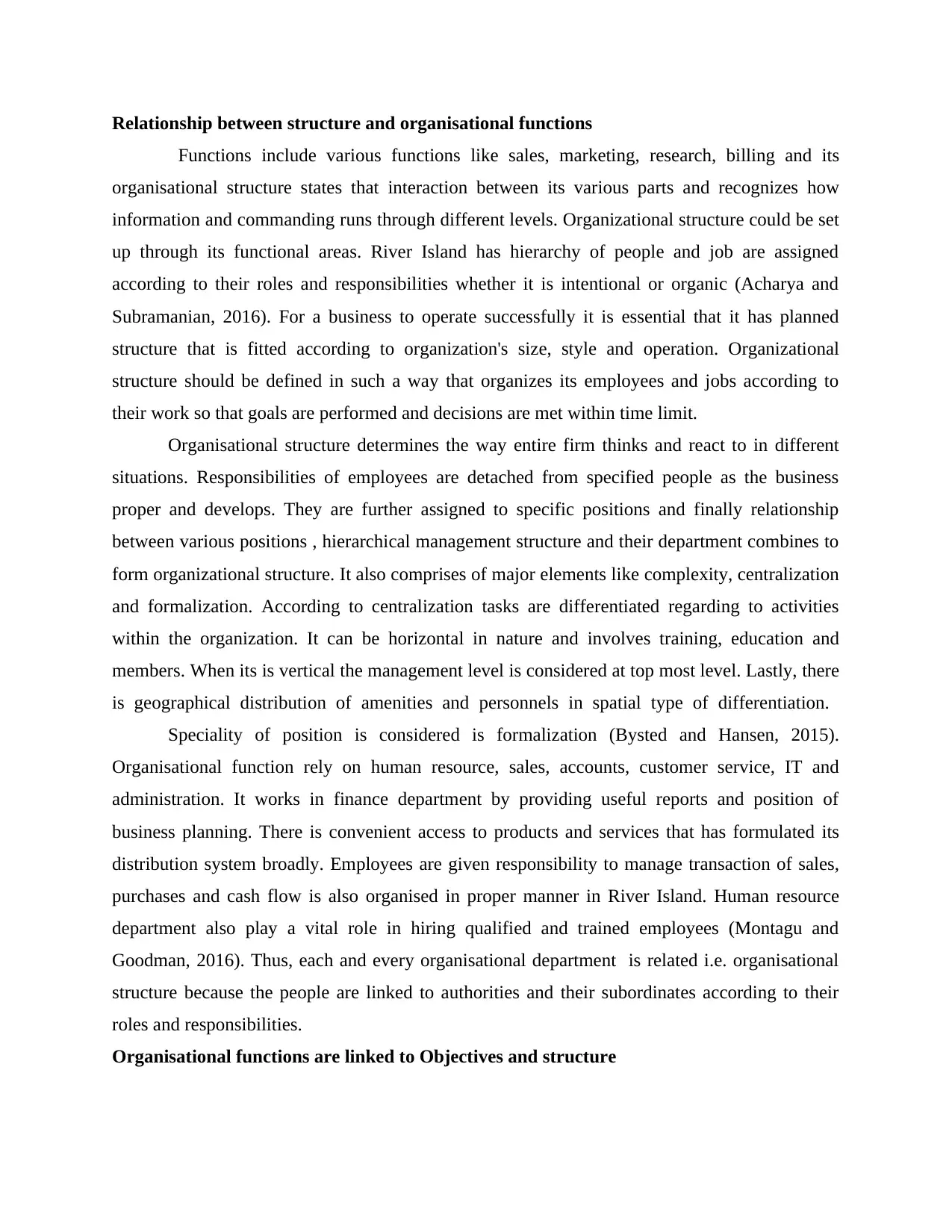
Relationship between structure and organisational functions
Functions include various functions like sales, marketing, research, billing and its
organisational structure states that interaction between its various parts and recognizes how
information and commanding runs through different levels. Organizational structure could be set
up through its functional areas. River Island has hierarchy of people and job are assigned
according to their roles and responsibilities whether it is intentional or organic (Acharya and
Subramanian, 2016). For a business to operate successfully it is essential that it has planned
structure that is fitted according to organization's size, style and operation. Organizational
structure should be defined in such a way that organizes its employees and jobs according to
their work so that goals are performed and decisions are met within time limit.
Organisational structure determines the way entire firm thinks and react to in different
situations. Responsibilities of employees are detached from specified people as the business
proper and develops. They are further assigned to specific positions and finally relationship
between various positions , hierarchical management structure and their department combines to
form organizational structure. It also comprises of major elements like complexity, centralization
and formalization. According to centralization tasks are differentiated regarding to activities
within the organization. It can be horizontal in nature and involves training, education and
members. When its is vertical the management level is considered at top most level. Lastly, there
is geographical distribution of amenities and personnels in spatial type of differentiation.
Speciality of position is considered is formalization (Bysted and Hansen, 2015).
Organisational function rely on human resource, sales, accounts, customer service, IT and
administration. It works in finance department by providing useful reports and position of
business planning. There is convenient access to products and services that has formulated its
distribution system broadly. Employees are given responsibility to manage transaction of sales,
purchases and cash flow is also organised in proper manner in River Island. Human resource
department also play a vital role in hiring qualified and trained employees (Montagu and
Goodman, 2016). Thus, each and every organisational department is related i.e. organisational
structure because the people are linked to authorities and their subordinates according to their
roles and responsibilities.
Organisational functions are linked to Objectives and structure
Functions include various functions like sales, marketing, research, billing and its
organisational structure states that interaction between its various parts and recognizes how
information and commanding runs through different levels. Organizational structure could be set
up through its functional areas. River Island has hierarchy of people and job are assigned
according to their roles and responsibilities whether it is intentional or organic (Acharya and
Subramanian, 2016). For a business to operate successfully it is essential that it has planned
structure that is fitted according to organization's size, style and operation. Organizational
structure should be defined in such a way that organizes its employees and jobs according to
their work so that goals are performed and decisions are met within time limit.
Organisational structure determines the way entire firm thinks and react to in different
situations. Responsibilities of employees are detached from specified people as the business
proper and develops. They are further assigned to specific positions and finally relationship
between various positions , hierarchical management structure and their department combines to
form organizational structure. It also comprises of major elements like complexity, centralization
and formalization. According to centralization tasks are differentiated regarding to activities
within the organization. It can be horizontal in nature and involves training, education and
members. When its is vertical the management level is considered at top most level. Lastly, there
is geographical distribution of amenities and personnels in spatial type of differentiation.
Speciality of position is considered is formalization (Bysted and Hansen, 2015).
Organisational function rely on human resource, sales, accounts, customer service, IT and
administration. It works in finance department by providing useful reports and position of
business planning. There is convenient access to products and services that has formulated its
distribution system broadly. Employees are given responsibility to manage transaction of sales,
purchases and cash flow is also organised in proper manner in River Island. Human resource
department also play a vital role in hiring qualified and trained employees (Montagu and
Goodman, 2016). Thus, each and every organisational department is related i.e. organisational
structure because the people are linked to authorities and their subordinates according to their
roles and responsibilities.
Organisational functions are linked to Objectives and structure
Paraphrase This Document
Need a fresh take? Get an instant paraphrase of this document with our AI Paraphraser
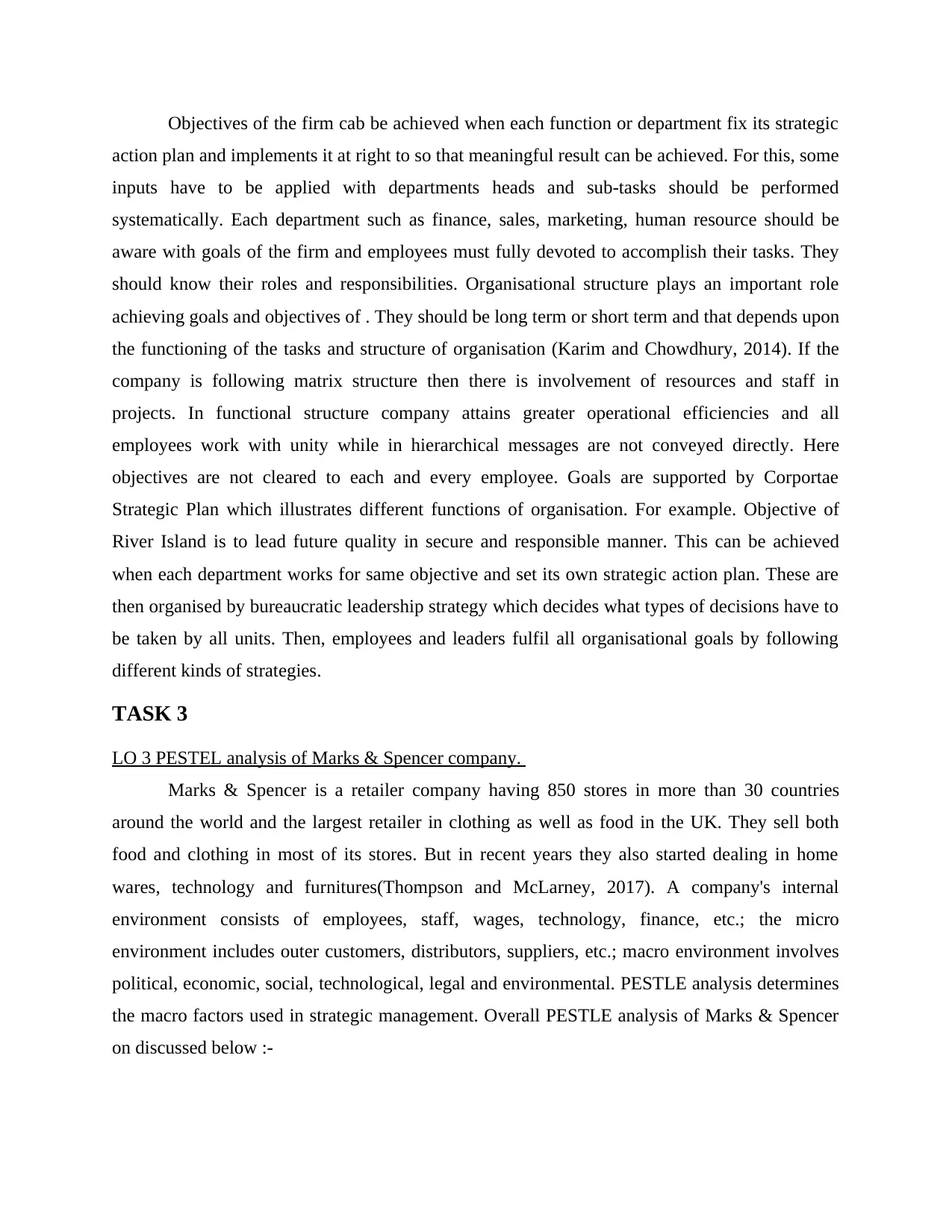
Objectives of the firm cab be achieved when each function or department fix its strategic
action plan and implements it at right to so that meaningful result can be achieved. For this, some
inputs have to be applied with departments heads and sub-tasks should be performed
systematically. Each department such as finance, sales, marketing, human resource should be
aware with goals of the firm and employees must fully devoted to accomplish their tasks. They
should know their roles and responsibilities. Organisational structure plays an important role
achieving goals and objectives of . They should be long term or short term and that depends upon
the functioning of the tasks and structure of organisation (Karim and Chowdhury, 2014). If the
company is following matrix structure then there is involvement of resources and staff in
projects. In functional structure company attains greater operational efficiencies and all
employees work with unity while in hierarchical messages are not conveyed directly. Here
objectives are not cleared to each and every employee. Goals are supported by Corportae
Strategic Plan which illustrates different functions of organisation. For example. Objective of
River Island is to lead future quality in secure and responsible manner. This can be achieved
when each department works for same objective and set its own strategic action plan. These are
then organised by bureaucratic leadership strategy which decides what types of decisions have to
be taken by all units. Then, employees and leaders fulfil all organisational goals by following
different kinds of strategies.
TASK 3
LO 3 PESTEL analysis of Marks & Spencer company.
Marks & Spencer is a retailer company having 850 stores in more than 30 countries
around the world and the largest retailer in clothing as well as food in the UK. They sell both
food and clothing in most of its stores. But in recent years they also started dealing in home
wares, technology and furnitures(Thompson and McLarney, 2017). A company's internal
environment consists of employees, staff, wages, technology, finance, etc.; the micro
environment includes outer customers, distributors, suppliers, etc.; macro environment involves
political, economic, social, technological, legal and environmental. PESTLE analysis determines
the macro factors used in strategic management. Overall PESTLE analysis of Marks & Spencer
on discussed below :-
action plan and implements it at right to so that meaningful result can be achieved. For this, some
inputs have to be applied with departments heads and sub-tasks should be performed
systematically. Each department such as finance, sales, marketing, human resource should be
aware with goals of the firm and employees must fully devoted to accomplish their tasks. They
should know their roles and responsibilities. Organisational structure plays an important role
achieving goals and objectives of . They should be long term or short term and that depends upon
the functioning of the tasks and structure of organisation (Karim and Chowdhury, 2014). If the
company is following matrix structure then there is involvement of resources and staff in
projects. In functional structure company attains greater operational efficiencies and all
employees work with unity while in hierarchical messages are not conveyed directly. Here
objectives are not cleared to each and every employee. Goals are supported by Corportae
Strategic Plan which illustrates different functions of organisation. For example. Objective of
River Island is to lead future quality in secure and responsible manner. This can be achieved
when each department works for same objective and set its own strategic action plan. These are
then organised by bureaucratic leadership strategy which decides what types of decisions have to
be taken by all units. Then, employees and leaders fulfil all organisational goals by following
different kinds of strategies.
TASK 3
LO 3 PESTEL analysis of Marks & Spencer company.
Marks & Spencer is a retailer company having 850 stores in more than 30 countries
around the world and the largest retailer in clothing as well as food in the UK. They sell both
food and clothing in most of its stores. But in recent years they also started dealing in home
wares, technology and furnitures(Thompson and McLarney, 2017). A company's internal
environment consists of employees, staff, wages, technology, finance, etc.; the micro
environment includes outer customers, distributors, suppliers, etc.; macro environment involves
political, economic, social, technological, legal and environmental. PESTLE analysis determines
the macro factors used in strategic management. Overall PESTLE analysis of Marks & Spencer
on discussed below :-
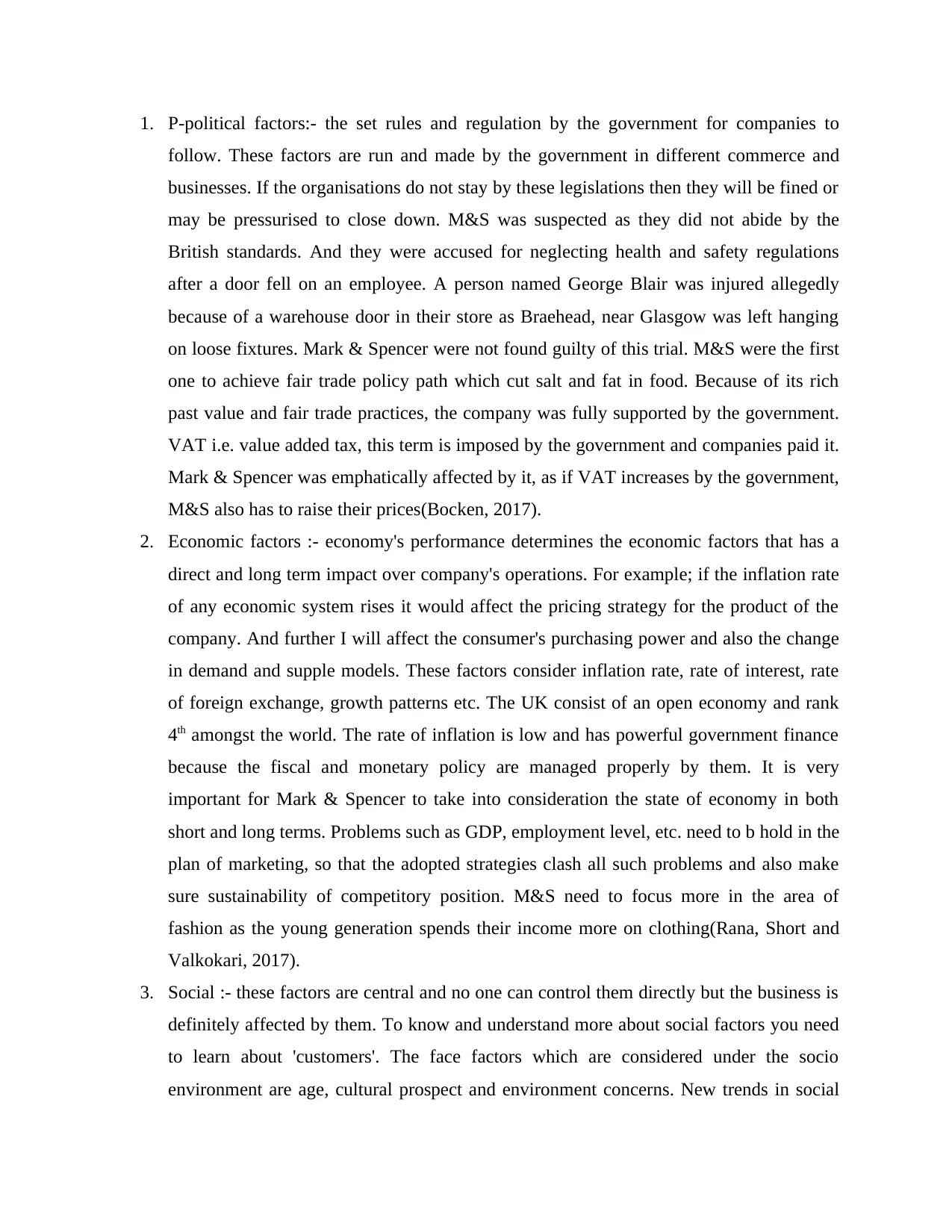
1. P-political factors:- the set rules and regulation by the government for companies to
follow. These factors are run and made by the government in different commerce and
businesses. If the organisations do not stay by these legislations then they will be fined or
may be pressurised to close down. M&S was suspected as they did not abide by the
British standards. And they were accused for neglecting health and safety regulations
after a door fell on an employee. A person named George Blair was injured allegedly
because of a warehouse door in their store as Braehead, near Glasgow was left hanging
on loose fixtures. Mark & Spencer were not found guilty of this trial. M&S were the first
one to achieve fair trade policy path which cut salt and fat in food. Because of its rich
past value and fair trade practices, the company was fully supported by the government.
VAT i.e. value added tax, this term is imposed by the government and companies paid it.
Mark & Spencer was emphatically affected by it, as if VAT increases by the government,
M&S also has to raise their prices(Bocken, 2017).
2. Economic factors :- economy's performance determines the economic factors that has a
direct and long term impact over company's operations. For example; if the inflation rate
of any economic system rises it would affect the pricing strategy for the product of the
company. And further I will affect the consumer's purchasing power and also the change
in demand and supple models. These factors consider inflation rate, rate of interest, rate
of foreign exchange, growth patterns etc. The UK consist of an open economy and rank
4th amongst the world. The rate of inflation is low and has powerful government finance
because the fiscal and monetary policy are managed properly by them. It is very
important for Mark & Spencer to take into consideration the state of economy in both
short and long terms. Problems such as GDP, employment level, etc. need to b hold in the
plan of marketing, so that the adopted strategies clash all such problems and also make
sure sustainability of competitory position. M&S need to focus more in the area of
fashion as the young generation spends their income more on clothing(Rana, Short and
Valkokari, 2017).
3. Social :- these factors are central and no one can control them directly but the business is
definitely affected by them. To know and understand more about social factors you need
to learn about 'customers'. The face factors which are considered under the socio
environment are age, cultural prospect and environment concerns. New trends in social
follow. These factors are run and made by the government in different commerce and
businesses. If the organisations do not stay by these legislations then they will be fined or
may be pressurised to close down. M&S was suspected as they did not abide by the
British standards. And they were accused for neglecting health and safety regulations
after a door fell on an employee. A person named George Blair was injured allegedly
because of a warehouse door in their store as Braehead, near Glasgow was left hanging
on loose fixtures. Mark & Spencer were not found guilty of this trial. M&S were the first
one to achieve fair trade policy path which cut salt and fat in food. Because of its rich
past value and fair trade practices, the company was fully supported by the government.
VAT i.e. value added tax, this term is imposed by the government and companies paid it.
Mark & Spencer was emphatically affected by it, as if VAT increases by the government,
M&S also has to raise their prices(Bocken, 2017).
2. Economic factors :- economy's performance determines the economic factors that has a
direct and long term impact over company's operations. For example; if the inflation rate
of any economic system rises it would affect the pricing strategy for the product of the
company. And further I will affect the consumer's purchasing power and also the change
in demand and supple models. These factors consider inflation rate, rate of interest, rate
of foreign exchange, growth patterns etc. The UK consist of an open economy and rank
4th amongst the world. The rate of inflation is low and has powerful government finance
because the fiscal and monetary policy are managed properly by them. It is very
important for Mark & Spencer to take into consideration the state of economy in both
short and long terms. Problems such as GDP, employment level, etc. need to b hold in the
plan of marketing, so that the adopted strategies clash all such problems and also make
sure sustainability of competitory position. M&S need to focus more in the area of
fashion as the young generation spends their income more on clothing(Rana, Short and
Valkokari, 2017).
3. Social :- these factors are central and no one can control them directly but the business is
definitely affected by them. To know and understand more about social factors you need
to learn about 'customers'. The face factors which are considered under the socio
environment are age, cultural prospect and environment concerns. New trends in social
⊘ This is a preview!⊘
Do you want full access?
Subscribe today to unlock all pages.

Trusted by 1+ million students worldwide
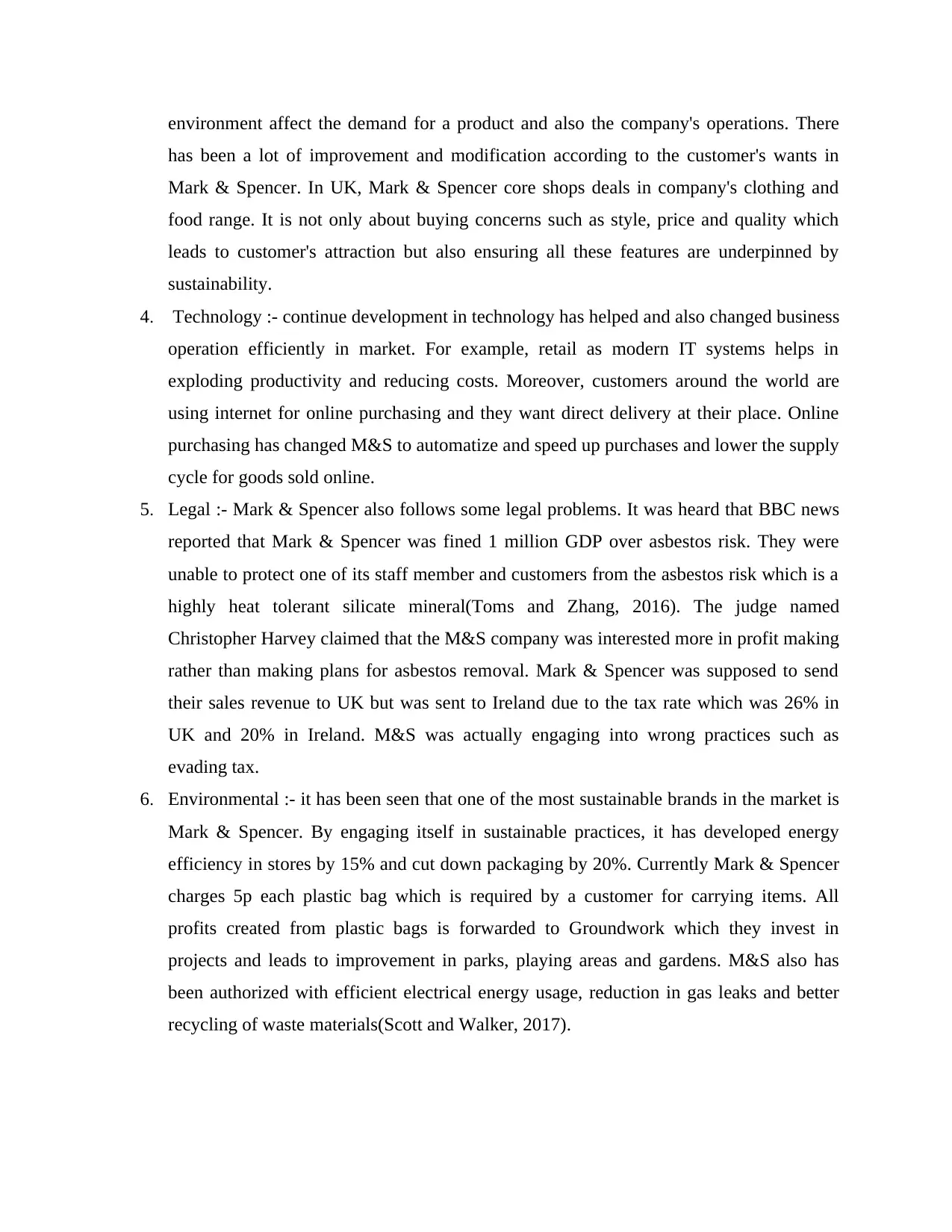
environment affect the demand for a product and also the company's operations. There
has been a lot of improvement and modification according to the customer's wants in
Mark & Spencer. In UK, Mark & Spencer core shops deals in company's clothing and
food range. It is not only about buying concerns such as style, price and quality which
leads to customer's attraction but also ensuring all these features are underpinned by
sustainability.
4. Technology :- continue development in technology has helped and also changed business
operation efficiently in market. For example, retail as modern IT systems helps in
exploding productivity and reducing costs. Moreover, customers around the world are
using internet for online purchasing and they want direct delivery at their place. Online
purchasing has changed M&S to automatize and speed up purchases and lower the supply
cycle for goods sold online.
5. Legal :- Mark & Spencer also follows some legal problems. It was heard that BBC news
reported that Mark & Spencer was fined 1 million GDP over asbestos risk. They were
unable to protect one of its staff member and customers from the asbestos risk which is a
highly heat tolerant silicate mineral(Toms and Zhang, 2016). The judge named
Christopher Harvey claimed that the M&S company was interested more in profit making
rather than making plans for asbestos removal. Mark & Spencer was supposed to send
their sales revenue to UK but was sent to Ireland due to the tax rate which was 26% in
UK and 20% in Ireland. M&S was actually engaging into wrong practices such as
evading tax.
6. Environmental :- it has been seen that one of the most sustainable brands in the market is
Mark & Spencer. By engaging itself in sustainable practices, it has developed energy
efficiency in stores by 15% and cut down packaging by 20%. Currently Mark & Spencer
charges 5p each plastic bag which is required by a customer for carrying items. All
profits created from plastic bags is forwarded to Groundwork which they invest in
projects and leads to improvement in parks, playing areas and gardens. M&S also has
been authorized with efficient electrical energy usage, reduction in gas leaks and better
recycling of waste materials(Scott and Walker, 2017).
has been a lot of improvement and modification according to the customer's wants in
Mark & Spencer. In UK, Mark & Spencer core shops deals in company's clothing and
food range. It is not only about buying concerns such as style, price and quality which
leads to customer's attraction but also ensuring all these features are underpinned by
sustainability.
4. Technology :- continue development in technology has helped and also changed business
operation efficiently in market. For example, retail as modern IT systems helps in
exploding productivity and reducing costs. Moreover, customers around the world are
using internet for online purchasing and they want direct delivery at their place. Online
purchasing has changed M&S to automatize and speed up purchases and lower the supply
cycle for goods sold online.
5. Legal :- Mark & Spencer also follows some legal problems. It was heard that BBC news
reported that Mark & Spencer was fined 1 million GDP over asbestos risk. They were
unable to protect one of its staff member and customers from the asbestos risk which is a
highly heat tolerant silicate mineral(Toms and Zhang, 2016). The judge named
Christopher Harvey claimed that the M&S company was interested more in profit making
rather than making plans for asbestos removal. Mark & Spencer was supposed to send
their sales revenue to UK but was sent to Ireland due to the tax rate which was 26% in
UK and 20% in Ireland. M&S was actually engaging into wrong practices such as
evading tax.
6. Environmental :- it has been seen that one of the most sustainable brands in the market is
Mark & Spencer. By engaging itself in sustainable practices, it has developed energy
efficiency in stores by 15% and cut down packaging by 20%. Currently Mark & Spencer
charges 5p each plastic bag which is required by a customer for carrying items. All
profits created from plastic bags is forwarded to Groundwork which they invest in
projects and leads to improvement in parks, playing areas and gardens. M&S also has
been authorized with efficient electrical energy usage, reduction in gas leaks and better
recycling of waste materials(Scott and Walker, 2017).
Paraphrase This Document
Need a fresh take? Get an instant paraphrase of this document with our AI Paraphraser
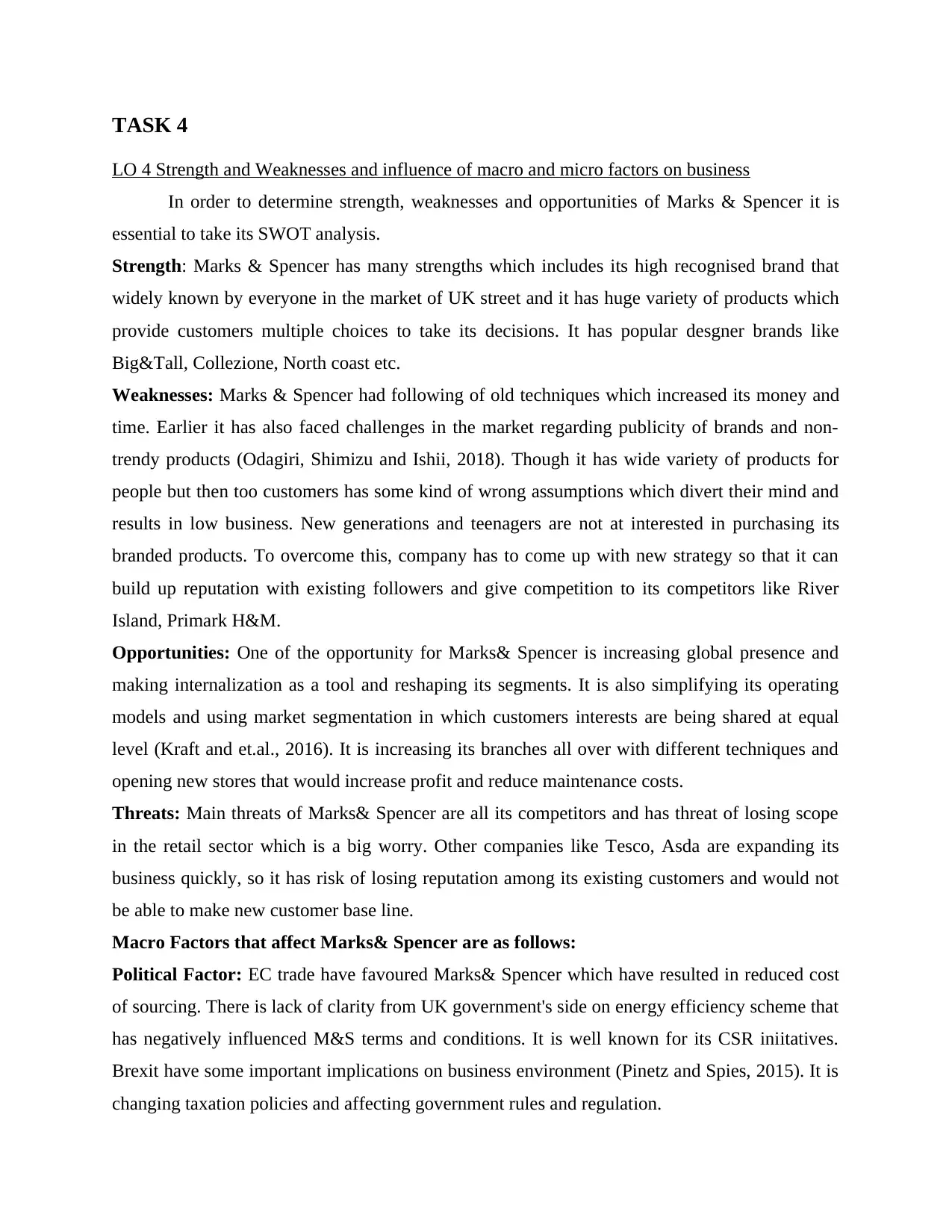
TASK 4
LO 4 Strength and Weaknesses and influence of macro and micro factors on business
In order to determine strength, weaknesses and opportunities of Marks & Spencer it is
essential to take its SWOT analysis.
Strength: Marks & Spencer has many strengths which includes its high recognised brand that
widely known by everyone in the market of UK street and it has huge variety of products which
provide customers multiple choices to take its decisions. It has popular desgner brands like
Big&Tall, Collezione, North coast etc.
Weaknesses: Marks & Spencer had following of old techniques which increased its money and
time. Earlier it has also faced challenges in the market regarding publicity of brands and non-
trendy products (Odagiri, Shimizu and Ishii, 2018). Though it has wide variety of products for
people but then too customers has some kind of wrong assumptions which divert their mind and
results in low business. New generations and teenagers are not at interested in purchasing its
branded products. To overcome this, company has to come up with new strategy so that it can
build up reputation with existing followers and give competition to its competitors like River
Island, Primark H&M.
Opportunities: One of the opportunity for Marks& Spencer is increasing global presence and
making internalization as a tool and reshaping its segments. It is also simplifying its operating
models and using market segmentation in which customers interests are being shared at equal
level (Kraft and et.al., 2016). It is increasing its branches all over with different techniques and
opening new stores that would increase profit and reduce maintenance costs.
Threats: Main threats of Marks& Spencer are all its competitors and has threat of losing scope
in the retail sector which is a big worry. Other companies like Tesco, Asda are expanding its
business quickly, so it has risk of losing reputation among its existing customers and would not
be able to make new customer base line.
Macro Factors that affect Marks& Spencer are as follows:
Political Factor: EC trade have favoured Marks& Spencer which have resulted in reduced cost
of sourcing. There is lack of clarity from UK government's side on energy efficiency scheme that
has negatively influenced M&S terms and conditions. It is well known for its CSR iniitatives.
Brexit have some important implications on business environment (Pinetz and Spies, 2015). It is
changing taxation policies and affecting government rules and regulation.
LO 4 Strength and Weaknesses and influence of macro and micro factors on business
In order to determine strength, weaknesses and opportunities of Marks & Spencer it is
essential to take its SWOT analysis.
Strength: Marks & Spencer has many strengths which includes its high recognised brand that
widely known by everyone in the market of UK street and it has huge variety of products which
provide customers multiple choices to take its decisions. It has popular desgner brands like
Big&Tall, Collezione, North coast etc.
Weaknesses: Marks & Spencer had following of old techniques which increased its money and
time. Earlier it has also faced challenges in the market regarding publicity of brands and non-
trendy products (Odagiri, Shimizu and Ishii, 2018). Though it has wide variety of products for
people but then too customers has some kind of wrong assumptions which divert their mind and
results in low business. New generations and teenagers are not at interested in purchasing its
branded products. To overcome this, company has to come up with new strategy so that it can
build up reputation with existing followers and give competition to its competitors like River
Island, Primark H&M.
Opportunities: One of the opportunity for Marks& Spencer is increasing global presence and
making internalization as a tool and reshaping its segments. It is also simplifying its operating
models and using market segmentation in which customers interests are being shared at equal
level (Kraft and et.al., 2016). It is increasing its branches all over with different techniques and
opening new stores that would increase profit and reduce maintenance costs.
Threats: Main threats of Marks& Spencer are all its competitors and has threat of losing scope
in the retail sector which is a big worry. Other companies like Tesco, Asda are expanding its
business quickly, so it has risk of losing reputation among its existing customers and would not
be able to make new customer base line.
Macro Factors that affect Marks& Spencer are as follows:
Political Factor: EC trade have favoured Marks& Spencer which have resulted in reduced cost
of sourcing. There is lack of clarity from UK government's side on energy efficiency scheme that
has negatively influenced M&S terms and conditions. It is well known for its CSR iniitatives.
Brexit have some important implications on business environment (Pinetz and Spies, 2015). It is
changing taxation policies and affecting government rules and regulation.
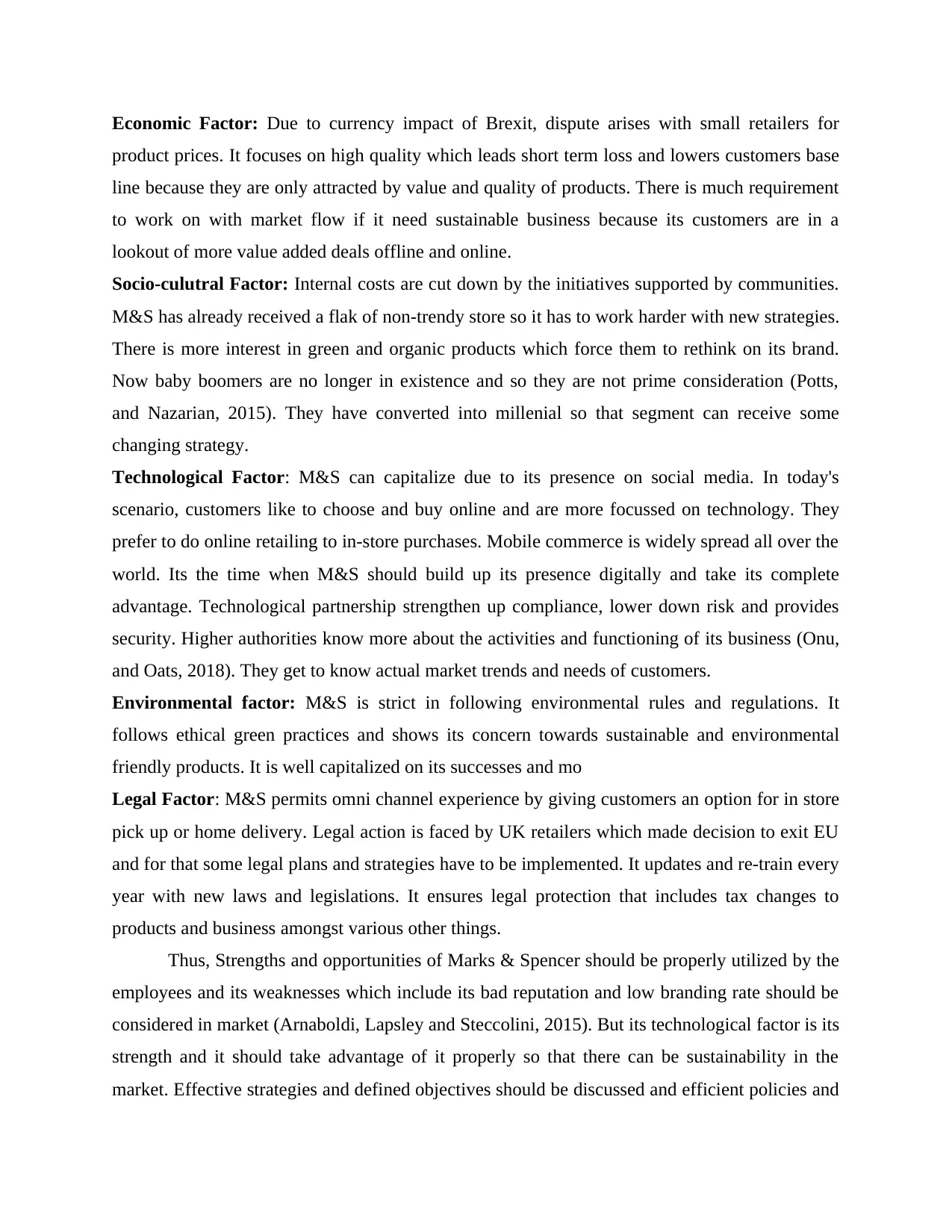
Economic Factor: Due to currency impact of Brexit, dispute arises with small retailers for
product prices. It focuses on high quality which leads short term loss and lowers customers base
line because they are only attracted by value and quality of products. There is much requirement
to work on with market flow if it need sustainable business because its customers are in a
lookout of more value added deals offline and online.
Socio-culutral Factor: Internal costs are cut down by the initiatives supported by communities.
M&S has already received a flak of non-trendy store so it has to work harder with new strategies.
There is more interest in green and organic products which force them to rethink on its brand.
Now baby boomers are no longer in existence and so they are not prime consideration (Potts,
and Nazarian, 2015). They have converted into millenial so that segment can receive some
changing strategy.
Technological Factor: M&S can capitalize due to its presence on social media. In today's
scenario, customers like to choose and buy online and are more focussed on technology. They
prefer to do online retailing to in-store purchases. Mobile commerce is widely spread all over the
world. Its the time when M&S should build up its presence digitally and take its complete
advantage. Technological partnership strengthen up compliance, lower down risk and provides
security. Higher authorities know more about the activities and functioning of its business (Onu,
and Oats, 2018). They get to know actual market trends and needs of customers.
Environmental factor: M&S is strict in following environmental rules and regulations. It
follows ethical green practices and shows its concern towards sustainable and environmental
friendly products. It is well capitalized on its successes and mo
Legal Factor: M&S permits omni channel experience by giving customers an option for in store
pick up or home delivery. Legal action is faced by UK retailers which made decision to exit EU
and for that some legal plans and strategies have to be implemented. It updates and re-train every
year with new laws and legislations. It ensures legal protection that includes tax changes to
products and business amongst various other things.
Thus, Strengths and opportunities of Marks & Spencer should be properly utilized by the
employees and its weaknesses which include its bad reputation and low branding rate should be
considered in market (Arnaboldi, Lapsley and Steccolini, 2015). But its technological factor is its
strength and it should take advantage of it properly so that there can be sustainability in the
market. Effective strategies and defined objectives should be discussed and efficient policies and
product prices. It focuses on high quality which leads short term loss and lowers customers base
line because they are only attracted by value and quality of products. There is much requirement
to work on with market flow if it need sustainable business because its customers are in a
lookout of more value added deals offline and online.
Socio-culutral Factor: Internal costs are cut down by the initiatives supported by communities.
M&S has already received a flak of non-trendy store so it has to work harder with new strategies.
There is more interest in green and organic products which force them to rethink on its brand.
Now baby boomers are no longer in existence and so they are not prime consideration (Potts,
and Nazarian, 2015). They have converted into millenial so that segment can receive some
changing strategy.
Technological Factor: M&S can capitalize due to its presence on social media. In today's
scenario, customers like to choose and buy online and are more focussed on technology. They
prefer to do online retailing to in-store purchases. Mobile commerce is widely spread all over the
world. Its the time when M&S should build up its presence digitally and take its complete
advantage. Technological partnership strengthen up compliance, lower down risk and provides
security. Higher authorities know more about the activities and functioning of its business (Onu,
and Oats, 2018). They get to know actual market trends and needs of customers.
Environmental factor: M&S is strict in following environmental rules and regulations. It
follows ethical green practices and shows its concern towards sustainable and environmental
friendly products. It is well capitalized on its successes and mo
Legal Factor: M&S permits omni channel experience by giving customers an option for in store
pick up or home delivery. Legal action is faced by UK retailers which made decision to exit EU
and for that some legal plans and strategies have to be implemented. It updates and re-train every
year with new laws and legislations. It ensures legal protection that includes tax changes to
products and business amongst various other things.
Thus, Strengths and opportunities of Marks & Spencer should be properly utilized by the
employees and its weaknesses which include its bad reputation and low branding rate should be
considered in market (Arnaboldi, Lapsley and Steccolini, 2015). But its technological factor is its
strength and it should take advantage of it properly so that there can be sustainability in the
market. Effective strategies and defined objectives should be discussed and efficient policies and
⊘ This is a preview!⊘
Do you want full access?
Subscribe today to unlock all pages.

Trusted by 1+ million students worldwide
1 out of 17
Related Documents
Your All-in-One AI-Powered Toolkit for Academic Success.
+13062052269
info@desklib.com
Available 24*7 on WhatsApp / Email
![[object Object]](/_next/static/media/star-bottom.7253800d.svg)
Unlock your academic potential
Copyright © 2020–2025 A2Z Services. All Rights Reserved. Developed and managed by ZUCOL.





